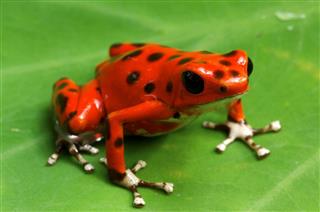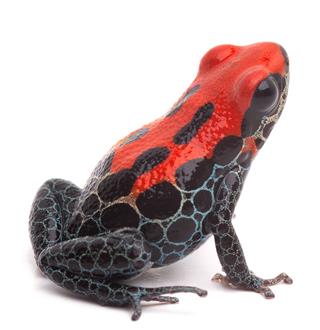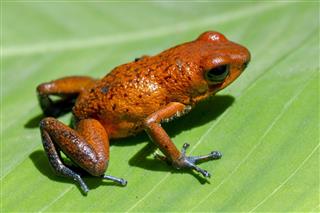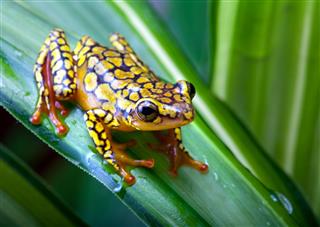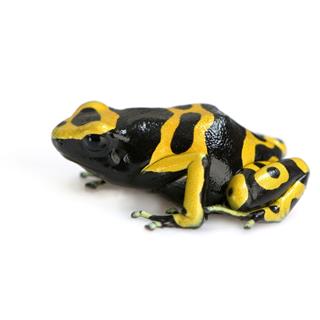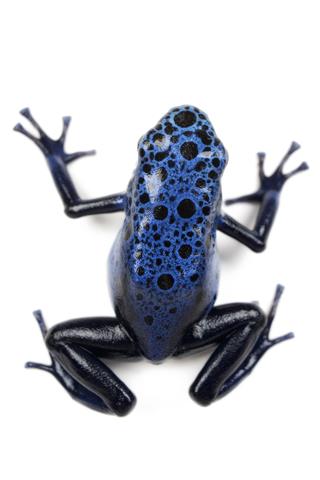
Through this article, know more about the poison dart frog, a good-looking killer from the wild.
Poison dart frogs are small, brightly-colored amphibians. But remember, some of them are also highly toxic. They are from the Dendrobatidae family, and look quite exquisite with some really cool patterns all over their skin.
Tiny, beautiful, attractive colors, and undoubtedly one of the most poisonous creatures on earth… the deadly combination that the poison dart frogs bear.
These deadly frogs are known by various names, like for example, the ‘poison arrow frog’ or the ‘dart poison frog’.
Although, it should be noted that, there are about 175 species of these frogs, although only three out of them are extremely toxic for human beings.
In the content that follows here, we will have a closer look at some of the interesting facts about these amazing amphibians.
Description
- The tiny poison dart frog is quite a show-off, and displays a range of brilliant colors on its skin. These frogs are a classic example of aposematism. Now aposematism is basically a defense mechanism where an organism uses various tactics to ward off potential predators. These tactics could vary from exhibiting bright colors and ultrasonic sounds to noxious odor. In simple words, the bright colors are a way of saying, ‘please don’t eat me!’
- These frogs are extremely small, given that their size is less than 2 and a half inches. In fact, the smallest can be the size of your thumbnail, and weigh as little as 2 grams.
- Their colors vary from the classic-golden to bright hues like red, yellow, green, blue, and black. The patterns also help them camouflage themselves among the forest foliage.
| Kingdom | Animalia |
| Phylum | Chordata |
| Class | Amphibia |
| Order | Anura |
| Family | Dendrobatidae |
| Genus | Dendrobates |
Habitat and Geographical Range
- Poison dart frogs love warm humid climatic conditions, and are mostly found in the tropical rainforests of countries like Costa Rica, Brazil, Venezuela, Columbia, and Ecuador, in the central and south of America.
- These frogs live in wet, moist places like streams, marshes, underneath rocks and leaves on the forest floor. They are mainly terrestrial, but they can climb trees easily.
- The poison dart enjoys the sun and extremely humid environments. Temperatures ranging from 72° F (22° C) to 80° F (27° C) are ideal for them.
Diet and Lifespan
- The poison arrow frogs are meat eaters. They have long, sticky tongues that zap out to catch their prey, which consists of fruit insects, termites ants, and small spiders.
- These frogs have a rather clever way of catching their prey. The bright colors of their skin attract insects towards them, and once the insect gets in contact with the deadly toxins from the skin glands, they experience instant death. Now that’s definitely fatal attraction!
- The average lifespan of the poison arrow is 3 to 5 years in the wild. However, in captivity, they are known to survive for 10 to 15 years too.
Reproduction
- The poison dart frog usually mates in the rainy season from mid-July to mid-September. They go through rather elaborate rituals of vocalization and fights for territories, to attract their female counterparts.
- Once the female chooses her partner, she lays a clutch of eggs in the forest canopy. The male fertilizes the eggs and makes sure they are moist. After about twelve days, these eggs turn into tiny little tadpoles.
- The poison frogs are surprisingly devoted parents. They are the only species in their family that take care of their young. When the eggs hatch, the male frog carries the tiny tadpoles on his back (they stick to the mucus on his back) and shifts them into pools of water collected in the leaves of certain plants. The female occasionally feeds them on unfertilized eggs till they go through metamorphosis and turn into adults.
Toxicity and Care
- These frogs use their toxins as a defense mechanism. They secrete lipophilic alkaloid toxins through their skin glands when they sense danger. These deadly poisons make up for their small size.
- It is believed that the poison comes from some of the insects the frogs feed on. The insects, in turn, acquire them from toxic plants. Scientists believe this, as the frogs that are raised in captivity do not show signs of toxins, since they do not feed on insects that have eaten poisonous plants.
- Due to their toxicity, these frogs have very few predators. Snakes and big spiders are usually the ones who feed on them, although they can turn out to be one deadly meal!
- The poison also has some medicinal use. Scientists use it in a painkiller, like epibatidine which is 200 times more powerful then morphine.
Other Facts
- The poison dart is so named, as some Amerindian tribes used their toxin to poison their blow darts for hunting.
- The golden poison frog is the one to look out for, as they are one of the most poisonous species in the world. It is believed that the venom of one golden poison frog can kill 10 humans.
- These frogs are so poisonous that one millionth of an ounce can kill a small animal, and an amount smaller than a grain of rice is enough to kill a human being. However, they are harmless if left alone.
- These frogs are sometimes kept as pets. The toxin is only harmful if it enters the bloodstream through open wounds, or if ingested.
- The Leimadophis epinephelus, a snake, is the only predator that has acquired resistance to the poison.
- Unlike other amphibians, this species is diurnal or nocturnal. They are active most of the day and sleep during the night.
- Poison dart frogs are not good swimmers, and are mostly ground dwellers.
- They are solitary creatures and only prefer companionship for mating.
- The green and black poison frog was introduced in Hawaii by humans. It is also the only species found there.
Conservation Status
Although the International Union for Conservation of Nature (IUCN) has listed these frogs as vulnerable, there are some species like the golden poison dart and blue poison dart that are critically endangered. This is mainly due to loss of habitat, environmental changes, and pollution. Collecting these exotic creatures for pet trade is another alarming reason for their decline in numbers.
